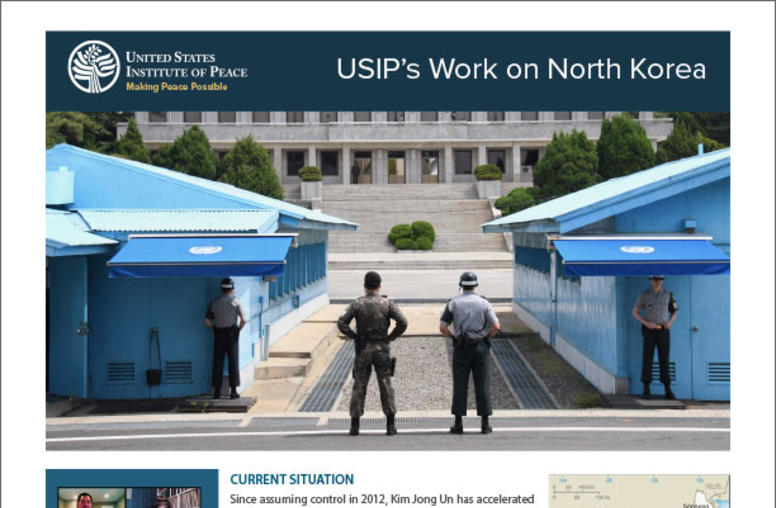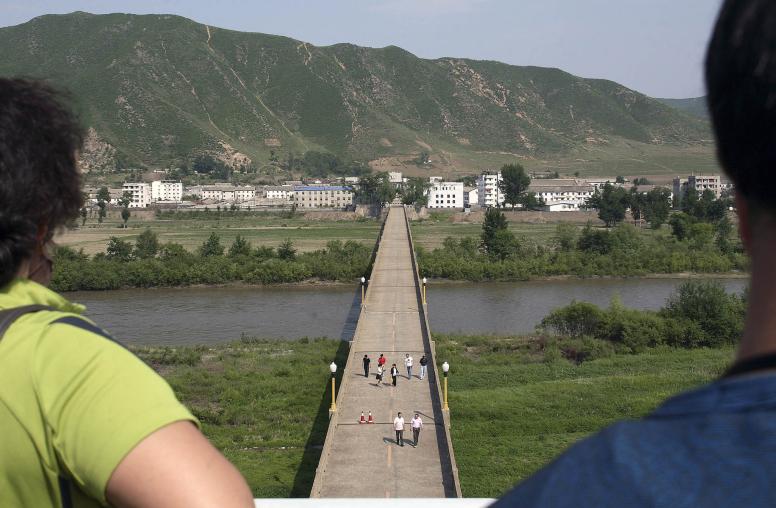Six-Party Talks: Defining A Realistic Roadmap for Success
This USIPeace Briefing outlines points to guide preparation for the fifth round of the Six-Party Talks.
The forthcoming resumption of Six-Party Talks to eliminate nuclear weapons from the Korean peninsula is expected to build on the Joint Statement of principles released at the end of the last round on September 19, 2005.
While some have criticized the vagueness of the Joint Statement, it represents the first tangible progress in identifying common principles and objectives in two years of sporadic meetings. If North Korea has indeed made a “strategic decision” to abandon its nuclear weapons programs – a thesis still to be tested – it may provide a basis for future progress. For this to occur, however, a more specific negotiating road map and implementing process must be developed. It is important to assess where the current guidelines might lead and to identify the "commitments for commitments" and "actions for actions" that might be envisioned as next steps.
Building on discussions with the Korea Working Group of the U.S. Institute of Peace, Scott Snyder, Ralph A. Cossa, and Brad Glosserman of the Center for Strategic and International Studies (CSIS) drafted the following points to guide preparation for the fifth round of the Six-Party Talks scheduled to begin on November 9, 2005. This USIPeace Briefing is the result of a joint project between the Pacific Forum of CSIS and the U.S. Institute of Peace. The views expressed are those of the authors and not necessarily those of the Institute, which does not take policy positions.
- Using the September 19 Joint Statement as the foundation, a new road map must be jointly developed, including specific simultaneous actions that would tie progress in North Korea's denuclearization to specified economic, political, and security benefits designed to normalize relations and end the stalemate on the Korean Peninsula, integrate North Korea into the regional economy, and enhance regional stability in Northeast Asia.
- A significant challenge for the next round of Six-Party Talks is to identify appropriate simultaneous and sequential actions that all parties can take to achieve these objectives. This process will require intensive input from technical experts in regular working-level contacts that should be convened to support diplomatic negotiations through the talks.
- The agreement must include sufficient irreversible action by North Korea to demonstrate to a skeptical U.S. that this “solution” will be more successful than was the Agreed Framework of 1994 in ending Pyongyang’s nuclear weapons activities.
- There is a limit to U.S. patience with protracted negotiations involving North Korea, due to fears that Pyongyang is using delaying tactics to advance its nuclear activities. A common definition of failure and/or agreement on both milestones and "redlines" among the other five parties is essential to overcome North Korea’s "divide and conquer" tactics, and to avoid the perception that it is Washington’s inflexibility or impatience rather than Pyongyang’s behavior that is at fault should the Talks falter.
- Another approach to overcome the risk of stalemate is taking reciprocal unilateral measures (RUMs); actions that North Korea would be expected to reciprocate under the slogan of "commitment for commitment, action for action." This approach has an important and relevant precedent: North Korea's decision to allow International Atomic Energy Agency (IAEA) inspections of nuclear sites in 1992 followed the George H. W. Bush administration's announcement that it would unilaterally remove forward-deployed ground-based tactical nuclear weapons from foreign countries worldwide.
- We suggest one reciprocal unilateral measure: a resumption of the supply of energy to North Korea with the expectation that North Korea would then declare its willingness to account for plutonium produced following its withdrawal from the Nuclear Non-Proliferation Treaty (NPT), accept inspections, and halt continued unilateral production of fissile material while the negotiation process proceeds. The planned resumption could be announced first but actual deliveries would await a freeze on ongoing activities involving the production of nuclear materials.
- North Korea’s tendency to play “divide and conquer” and exploit divisions among the other five countries requires the U.S. to work closely with the other four interlocutors, and especially with South Korea and China. Any failure to achieve a full consensus on a road map process would likely result in a severe deterioration of U.S. relations with South Korea and/or China.
- Key issues in the next phase of negotiations include the sequencing of North Korea's right to receive light-water reactors and the exercise of that right; Pyongyang’s return to compliance with the NPT and IAEA; the scope, methods, and nature of any verification process; and types of security guarantees that may be offered as part of a negotiated solution. Washington, Seoul, and Beijing (at a minimum) must develop a common position on these issues. Presumably, there is already a consensus among the parties that North Korea must explain its uranium-related activities as part of its denuclearization and on the “appropriate time” to discuss peaceful nuclear energy programs in the North.
- Given the limited room for maneuver provided to North Korean negotiators, a successful negotiation in the six-party format may ultimately require direct high-level contact with key decision-makers in Pyongyang. A high-level approach to the issue might require changing the scope of the negotiations: rather than focusing solely on North Korea's denuclearization, negotiations should address the larger question of how to end the Korean War and bring lasting peace to the Korean Peninsula. In this context, the nuclear agreement would be one component of the larger deal.
- The U.S. and Republic of Korea (ROK) must reach prior agreement on alliance issues that might be involved in negotiations with North Korea on a peace regime, including the reconfiguration of U.S. Forces Korea and negotiations over transfer of wartime command to the Republic of Korea. Alliance issues have traditionally (and rightfully) been viewed as a bilateral issue between allies; neither Washington nor Seoul should unilaterally negotiate such issues directly with North Korea if they expect the alliance to survive. A common U.S./ROK position is needed prior to negotiations on new peace arrangements on the Korean Peninsula.
- The United States should continue efforts outside (and not linked to) the Six-Party Talks to require North Korea to respect international standards in human rights, drug trafficking, and counterfeiting of U.S. currency. North Korea's compliance with international norms and laws will be a critical part of any process that leads to normal relations between Washington and Pyongyang.
- Security assurances will be a vital component of any agreement. There must be credible guarantees from Washington and from Pyongyang that they harbor no hostile intent as well as commitments from all participants in underwriting, verifying, and enforcing these and other security-related assurances. Tokyo's security (and political) concerns must also be addressed.
About the Authors
This USIPeace Briefing was written by Scott Snyder, Ralph A. Cossa, and Brad Glosserman with the Pacific Forum at the Center for Strategic and International Studies as part of a joint project with the Institute of Peace. The views expressed here are not necessarily those of the Institute, which does not advocate specific policies.
The United States Institute of Peace is an independent, nonpartisan institution established and funded by Congress. Its goals are to help prevent and resolve violent international conflicts, promote post-conflict stability and development, and increase conflict management capacity, tools, and intellectual capital worldwide. The Institute does this by empowering others with knowledge, skills, and resources, as well as by directly engaging in peacebuilding efforts around the globe.



